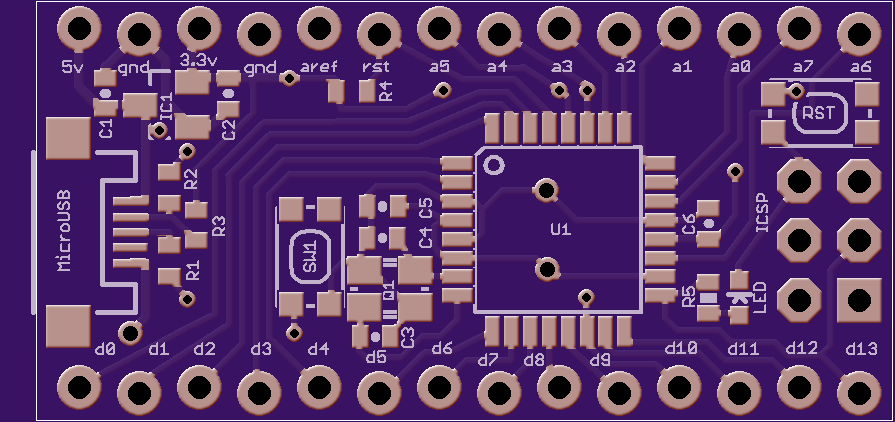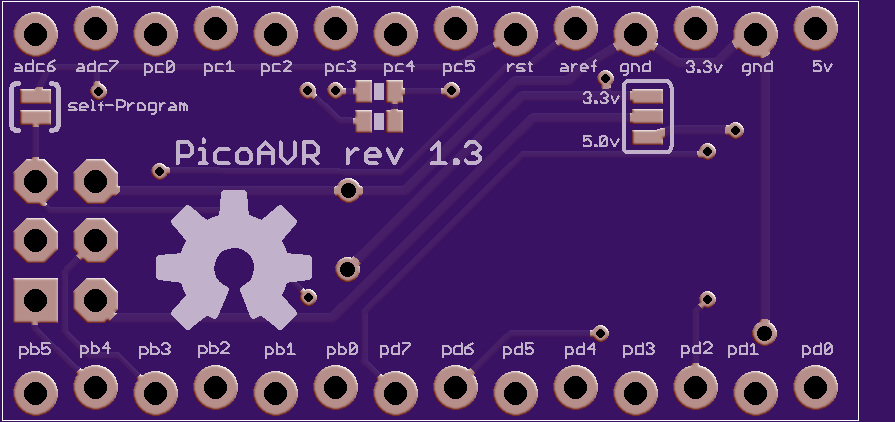PicoAVR
PicoAVR is an open source AVR development board which aims to a minimalistic but fully functional alternative to Arduino. The PicoAVR board measures less than 1 square inch, and for less than 10$ you can buy all the components to build your own.

The PicoAVR can be powered and programmed through a standard MicroUSB connector, the same connector used by android phones and tablets. PicoAVR uses the V-USB software implementation of the USB stack, and when connected to your computer can easily be programmed to emulate a keyboard, mouse or any other HID device.
The PicoAVR board is similar in capabilities to the Arduino UNO, Arduino Micro or the Arduino Leonardo, but by using an atmega328p and V-USB instead of an FTDI chip or an atmega328u4 the number of components and the cost of the PicoAVR is significantly reduced.
Since PicoAVR uses the same protocol as the usbasp for programming, it is supported by the latest versions of avrdude. As a result of this both Atmel Studio 6 or the Arduino Software can be used as complete development environments for the PicoAVR. However, you are not constrained to these, and you can easily develop for the PicoAVR using avr-gcc, avrdude and the editor of your choice.
In its default configuration the PicoAVR runs at 12 Mhz and operates at 3.3 V, which makes it easy to interface to the newer 3.3 V devices without requiring a level shifter.
PicoAVR may be interesting to you if...
- You are already developing hardware projects using an Arduino, but you would prefer to build your own hardware.
- You want to get started with AVR microcontrollers, but don't want to spend 25$ on an Arduino UNO or an Arduino Micro.
- You want an AVR development board which has a standard 6-pin ICSP connector and can be used as an ICSP programmer for other microcontrollers.
- You want to create a board of your own using an AVR microcontroller and you are looking for a simple reference design.
Build Your Own
You can buy the components to build your own for less than 10$ per board.
Moreover, keep in mind that due to economies of scale, building 100 or 1000 PicoAVR's is significantly cheaper per unit than building a single board.
The only equipment required to build your own PicoAVR is a soldering iron and an ICSP programmer to flash the bootloader (more on that below).
BOM
| Part | Description | Package | DigiKey Part # | Price ($) |
|---|---|---|---|---|
| C1,C2 | 4.7uF Capacitor | 402 | 1276-1056-1-ND | 0.23 x 2 |
| C3,C4 | 22pF Capacitor | 402 | 1276-1681-1-ND | 0.1 x 2 |
| C5,C6 | 0.1uF Capacitor | 402 | 1276-1443-1-ND | 0.1 x 2 |
| R1,R2 | 68 Ohm Resistor | 402 | RMCF0402JT68R0CT-ND | 0.02 x 2 |
| R3 | 1.5k Ohm Resistor | 402 | RMCF0402JT1K50CT-ND | 0.02 x 1 |
| R4 | 10k Ohm Resistor | 402 | RMCF0402JT10K0CT-ND | 0.02 x 1 |
| R5 | 220 Ohm Resistor | 402 | RMCF0402JT220RCT-ND | 0.02 x 1 |
| Q1 | 12 Mhz Crystal | 3.2 x 2.5mm | 887-2355-1-ND | 0.71 x 1 |
| U1 | Atmega328p | TQFP-32 | ATMEGA328P-AU-ND | 3.61 x 1 |
| IC1 | MCP1700 Voltage Regulator | SOT23 | MCP1700T3302ETTCT-ND | 0.44 x 1 |
| X1 | MicroUSB Connector | USB-MICRO | 609-4613-1-ND | 0.46 x 1 |
| SW1 | Tactile Switch | 3mm x 4mm | CKN10502CT-ND | 0.28 x 1 |
The total comes to less than 6.5$ per board. Digikey offers educational and bulk discounts.
PCB
You can get 3 PCB's from oshpark.com for only 5$ including shipping. That is less than 2$ per PicoAVR board!
The eagle board files are available in the repository.
Below is a rendering of the top and bottom of the PCB.


Flashing the Bootloader
To get the PicoAVR usbasp-based bootloader flashed into the AVR chip you will need either: a dedicated ICSP programmer, an Arduino and jumper cables, or an already functioning PicoAVR.
The PicoAVR provides a standard 6-pin ICSP connector that can be used to either flash the bootloader into the board (by closing the self-program jumper), or to act as an ICSP programmer to reprogram any other AVR board (including another PicoAVR or an Arduino) using a standard 6-pin ICSP connector.